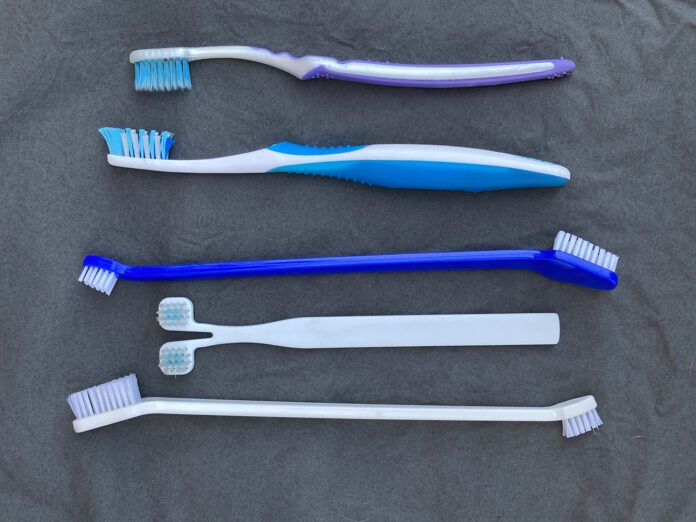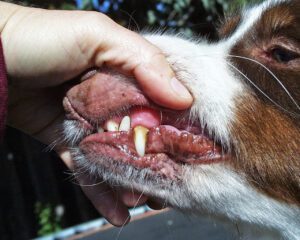
We often pay attention to our dog’s teeth, but the gums supporting those teeth are just as important. Unfortunately, they’re frequently ignored. As a result, gum disease is epidemic in dogs. Recent studies show that by the time they are two years old, almost 90% of America’s dogs have some type of periodontal disease.
This progressive illness is caused by mouth bacteria that harm gums and bones. Unfortunately, periodontal disease is invisible to the untrained eye until it causes significant damage, so prevention is an important strategy.
For more on what unhealthy dog gums look like, read our companion article, Healthy Dog Gums vs Unhealthy Dog Gums: The Colors to Watch Out For.
The causes of periodontal disease in dogs include:
- poor dental hygiene
- genetics
- malocclusion (having a misaligned bite)
- the shape of a dog’s mouth.
Brachycephalic breeds (those with shortened snouts) and small or toy breeds are at greater risk than other dogs, as are older and overweight dogs in general.
How Periodontal Disease in Dogs is Diagnosed

Veterinarians diagnose four stages of periodontal disease by checking for abnormal spaces between teeth and gums and by taking x-rays while the dog is under general anesthesia. Without dental x-rays, it’s impossible to accurately diagnose periodontal disease.
Stage 1, also known as gingivitis, consists of gum inflammation with no bone loss or tooth detachment. The symptoms include red or puffy gums, bad breath, and gums that bleed during chewing or brushing. This is the only periodontal stage that can be reversed; the others cause permanent damage.
Stage 2 produces up to a 25% loss of tooth attachments, mild bone loss, and mildly abnormal periodontal pocket depths, which are spaces around teeth below the gum line. In addition to Stage 1 symptoms, Stage 2 patients have receding gums.
Stage 3 shows a loss of 25 to 50% of the tooth’s support. In addition to the preceding symptoms, this stage results in loose teeth. Advanced dental procedures and daily home care are needed to save affected teeth, which are otherwise pulled at this stage.
Stage 4 is the final and most serious stage of periodontal disease, with X-rays and periodontal probing showing more than 50% loss of tooth attachments. Stage 4 symptoms include tooth root exposure, missing and loose teeth, and pus oozing from around the teeth. The treatment for this phase is tooth extraction, and the prognosis for dogs in this condition is poor.
As periodontal disease in dogs progresses:
- dogs flinch or pull away when anyone tries to inspect their teeth
- their chewing patterns change
- they smack their gums
- they don’t tolerate having their teeth brushed because the gums are painful
- they no longer enjoy playing with chew toys
- their behavior may become more withdrawn or aggressive
Left untreated, dental disease adversely affects all of the body’s organs, including the heart, lungs, liver, and kidneys. The constant release of bacterial infections from the mouth to the rest of the body is a form of systemic poisoning. A study published in the April-June 2021 Open Veterinary Journal found that periodontal disease is associated with cognitive dysfunction in aging dogs. Keeping your dog’s gums healthy makes a rewarding investment in his old age.
Anesthesa-free dentals are popular with owners who worry about putting their dogs under anesthesia, but it’s impossible to get even the best-mannered dog to hold still for cleaning their teeth below the gum line – which is the most critical area to clean in order to prevent periodontal disease. Says canine health researcher and owner of the DogAware.com website Mary Straus, “Anesthesia-free dentals are cosmetic procedures that do not contribute to your dog’s health and may even disguise problems, since the teeth look clean.”
How to Keep Dog’s Gums and Teeth Healthy
To help prevent oral health problems, check your dog’s mouth for signs of gingivitis, plaque, and tartar. This is easy to do if you brush your dog’s teeth every day. If not, gently lift her upper lip to look at her front and side teeth, then pull the corner of her mouth back so you can see top and bottom teeth further back in her mouth. Repeat on the other side. Frequent checks will call your attention to something that needs immediate attention, such as a broken tooth or something caught between the teeth.
An early symptom of gingivitis is a thin red line along the gumline, which can increase in width if the illness progresses. A thorough exam, including x-rays, will show the extent of periodontal disease and determine appropriate treatment. Prompt veterinary attention can prevent further damage, and your at-home attention will help as well.
Dental plaque is a sticky, colorless biofilm of microorganisms that grows between, in front of, and behind teeth, on chewing surfaces, and along and below the gumline. It continuously forms on tooth enamel and unless removed by brushing, flossing, or other mechanical means, plaque hardens and forms tartar. Also known as dental calculus, tartar builds up on teeth, often turning brown or pale yellow.
Brushing your dog’s teeth can be an important step in preventing the accumulation of plaque and tarter. It’s easier to introduce brushing to puppies and young dogs but even older dogs can learn to sit still for brushing. For an inspiring story about how powerful this home care can bee, see “Save Your Dog’s Teeth With Home Care,” WDJ December 2014.
Alternatives to Using a Toothbrush On Your Dog’s Teeth
If a gentle approach, poultry-flavored toothpaste, and a soft toothbrush convince your dog to go along with brushing, consider supplements that can be added to food or water to address plaque and gingivitis.
Pet water additives sold as breath fresheners claim to enhance digestive health, improve nutrient absorption, and help dogs smell better. A small amount, such as a capful, is added to every bowl of drinking water. Some contain digestive enzymes, micronized minerals, or ingredients known to minimize plaque and tartar buildup.
Unfortunately, some of these additives contain xylitol, a no-calorie sweetener that is toxic to dogs. While the small amounts used according to label directions are considered safe for dogs, some veterinarians are concerned that the daily ingestion of xylitol may pose a risk. Check the label to make sure the product you buy does not contain xylitol.
Success depends on the product as well as how it is introduced to your dog; start with smaller-than-recommended quantities and respect your dog’s preferences.
Studies published in the medical literature show that probiotics (“friendly” or beneficial bacteria) can help prevent the buildup of plaque and tartar in humans, leading some manufacturers to create oral health supplements for dogs. No specific strains of probiotics have been proven to remove canine plaque and tarter, but some veterinarians who recommend probiotics for dogs have reported improvement in their patients’ oral health.
What to Know About Dogs, Bones and Chewing
Raw bones can clean teeth and gums while providing chewing pleasure and jaw exercise. However, bones can cause broken teeth, especially if their size and shape allow dogs to get them between their molars and crunch down. Marrow bones are a particular risk. Knuckle bones may be safer because of their shape, especially for large dogs and aggressive chewers. For best results, feed raw, fresh bones and remove them once the meat has been eaten, before they dry out. Cooked bones can splinter and are not recommended.
Chew toys can keep your dog busy and some, like Zesty Paws Probiotic OraStix, provide beneficial bacteria that support the oral microbiome. Nylabone Dental Chew Bones, made of a flexible thermoplastic polymer, feature dental tips that reduce plaque and help prevent tarter buildup. Offer your dog a choice of safe chew toys to help improve her gum health.




